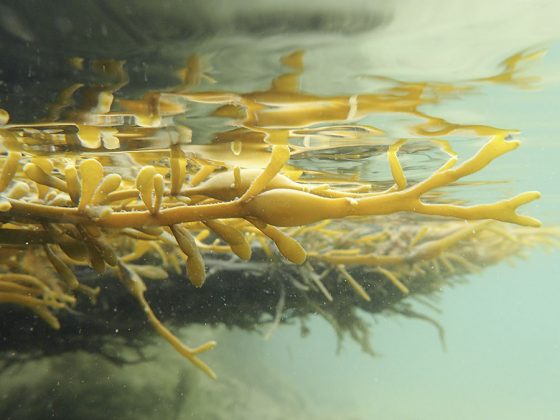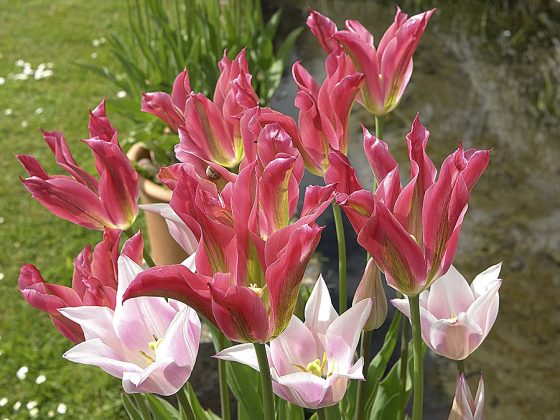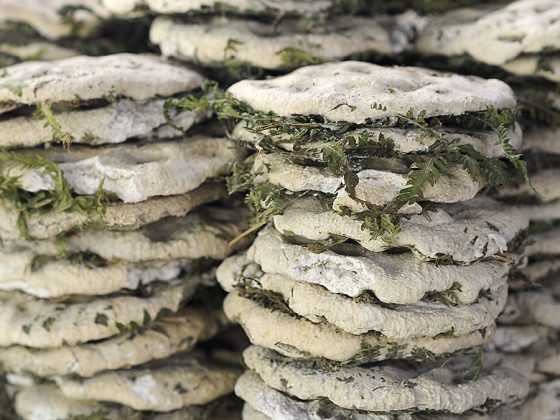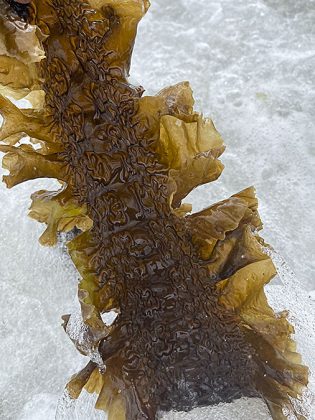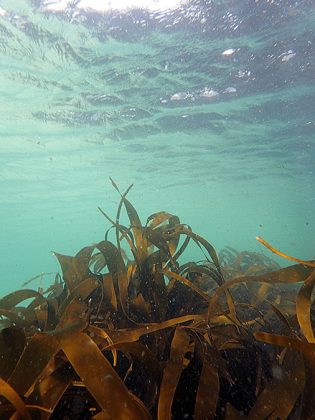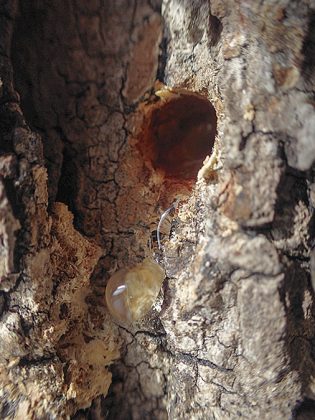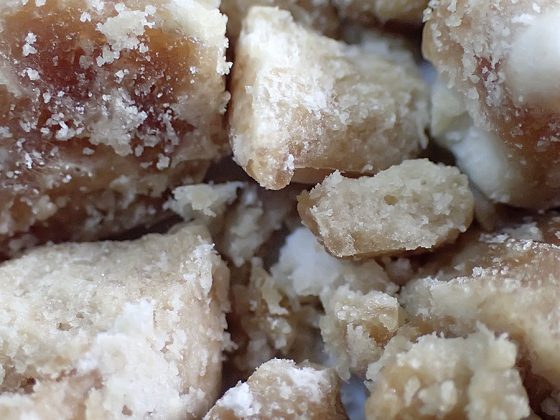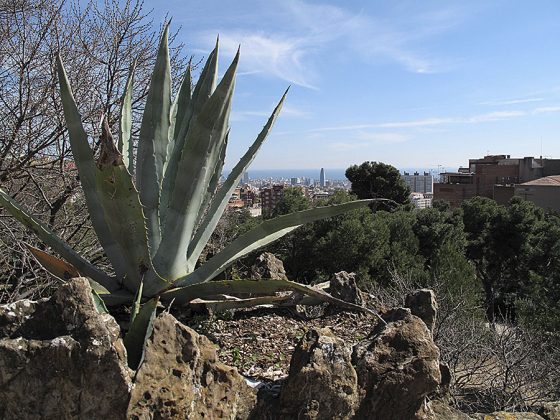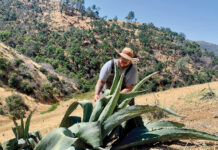Thinking about types of grain used to make whiskey — barley, corn, rye, wheat — is also a list of domesticated species that are the workhorses of agriculture and base spirit in North America and Europe. Similarly, fruits that are fermented and distilled are domesticates, which offer abundant yields such as apples and grapes. There is a much wider range of botanicals offering fermentable sugars that can be turned into base spirit than are currently used. Other candidates for high yields are wild species that benefit and are abundant under new conditions, for example some species of seaweed move further north as water temperatures increase. Looking at different climactic regions also highlights the wide range of sources of base spirit that currently are little used within North America. Agave (Agave americana, Agave angustifolia) provides fermentables for tequila and mescal. Sap tapped from coconut flowers is used to make arrack in Sri Lanka. Our reliance on specific grains and fruits is directed by what crops offer high yields under prevalent growing conditions.
Perhaps the first plant rich in sugar that springs to mind in North America is sugar maple (Acer saccharum). Maple sap can be condensed into sweet syrup, and when heated further it can be crystalized into sugar. Sugar maple sap is significantly sweeter than that of close relatives such as Norway maple (Acer platanoides) or other tree species with edible sap such as sweet birch (Betula lenta). But the yield of fermentable sugar in return for the work of tapping sap and energy consumption to condense its sugars is not sufficient to make it economically viable for producing base spirit.
In the western Netherlands, where fields of flowering bulbs grown for horticulture are an annual spectacle, the most famous adopted flower is making inroads into spirit distillation. Bulbs of tulips (Tulipa spp) were the ornamental crop that saved people from starving during the Hunger Winter of 1944 to 1945 when a wartime embargo on food transport, harsh winter, and limited local harvest left people with little to eat. At soup kitchens in the cities tulip bulbs were cooked as a source of carbohydrates. Now Clusius Craft Distillers makes two types of tulip vodka. Its grain and tulip blend retails at €48 and contains the equivalent of 40 tulip bulbs. Its pure tulip vodka uses 350 bulbs per bottle and retails at €295 per bottle. While the cost of base spirit from tulip bulbs is higher than from grain, the strong association of tulips with the Netherlands adds viability to tulip spirit. Even though tulips originate from Central Asia.
Moving beyond fermentation with just yeast (Saccharomyces cerevisiae) there are further options. During the process of malting, triggered growth of wheat and barley releases enzymes, which break down starch into glucose. Similarly while sake uses yeast to produce alcohol, the process relies on koji fungus (Aspergillus oryzae) to break down the complex carbohydrates in rice to simple sugar that can be fermented by yeast. In contrast to yeast, which is a single cell organism, koji fungus is filamentous and grows hyphae. To make sake polished and then steamed rice is inoculated with koji fungus, and kept at ideal growing conditions so that koji fungus hyphae penetrate the rice. Enzymes produced by koji fungus break down starch to glucose. Filamentous fungi often produce more enzymes when growing on solid material than when immersed in liquid. Yeast, more rice, and water are added for the fermentation. Sake flavor is shaped by choices such as the extent to which rice is polished and strain of yeast selected. All sake relies on the action of koji mold to make fermentable sugar available for yeast to produce alcohol.
Another fermentation process that relies on a phase of solid-state microbial growth and more than one microorganism is production of millet beer, known as tongba or jnard, served in Bhutan, Nepal, Sikkim, and Tibet. There are many species of millet, the type used for beer making in the Himalayas is finger millet (Eleusine coracana). After being cooked the grains are allowed to cool and then inoculated with a culture of yeasts, filamentous fungi, and bacteria. Brewing culture blends can be seen sold on markets in Bhutan as dried discs. Alongside standard brewer’s yeast (Saccharomyces cerevisiae) the mixture of microbes used to make tongba can include other yeasts such as Saccharomycopsis fibuligera, filamentous fungi such as Amylomyces rouxii and Rhizopus oryzae, and lactic acid bacteria Enterococcus faecalis and Pediococcus pentosaceus. In this fermentation filamentous fungi make simple sugar available, yeasts convert sugar to alcohol, and lactic acid bacteria are responsible for the slightly sour taste of the end product. Kept damp but not submerged in water, inoculated millet grains are allowed to ferment. Water is added at the stage of serving the beer. A bamboo straw is placed in a bamboo cup to which the fermented grains are added and then covered with hot water. After waiting several minutes the beer can be drunk. The cup can be refreshed several times by refilling with water. Although individual millet grains are small, millets are a versatile crop that yield in arid conditions and in low fertility soil.
Seaweeds, like terrestrial plants, create glucose during photosynthesis but seaweeds store glucose in different carbohydrate forms than terrestrial plants not as starch or fructose. Brown macroalgae or kelps are a fast growing source of carbohydrates in the form of laminarin. Different species have different laminarin content for example rockweed (Ascophyllum nodosum) contains less laminarin than oarweed (Laminaria digitata). Standard fermentation via brewer’s yeast (Saccharomyces cerevisiae) alone does not work on kelps. While research has been carried out on fermenting seaweed to make ethanol as a biofuel, fermenting seaweed for food grade alcohol is in early stages of development. One option for fermenting kelps is via co-fermentation using both brewer’s yeast and recombinant yeasts that can convert pentose, a type of sugar found in seaweeds, into alcohol. Another approach is using an engineered strain of Esherichia coli that uses the biochemical pathway from Vibrio splendidus, a marine microbe, for breaking down alginate to sugar that can then be fermented. An advantage of seaweeds as a source of biomass that can be converted into alcohol is the ease of cultivating seaweeds. Their main requirement is structure to grow on in water that suits their environmental preferences and they do not need fertilizer or irrigation.
Creating base spirit relies on abundance. Either high yields of agriculture or conditions in which a species is thriving in the wild and can provide volumes of material needed. As climatic conditions in the USA are changing, alternate crops provide a means of maintaining yields. Working with different processes including solid-state ferments and making use of an additional microorganism to break down complex carbohydrates increases the number of ingredients that work as fermentables for distillation.

